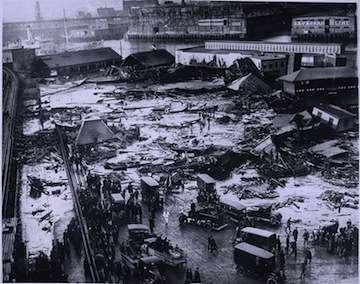The Great Molasses Disaster

The aftermath of the molasses disaster. Boston Globe Photo, Courtesy Boston Public Library
On Jan. 15, 1919, a large molasses storage tank burst in Boston’s North End, and a 25-foot-high wave of molasses surged through the streets at 35 miles per house.
Twenty-one people were killed, including 17 workers, and 150 were injured. Witnesses said the rivets popping out of the tank sounded like a machine gun.
The tank, 50 feet high and 90 feet in diameter, contained 2.3 million gallons of molasses originally destined to be made into rum. The deadly goo damaged the Boston Elevated Railway on Atlantic Avenue, tipped over a rail car and knocked buildings off their foundations. The molasses surge picked up a truck and threw it into Boston Harbor.
Inside the Boston and Worcester freight terminal, the river of molasses poured through the doors and windows, killing workers like trapped animals.
Outside, some people were caught by the wall of goo, some hurled into the air, some flung against freight cars, some smothered by the boiling sludge.
The molasses was waist deep in the streets, and covered struggling forms trying to escape the sticky mass. It was hard to tell if they were men, women, children or horses. The more they struggled, the more ensnared they became.
The USS Nantucket, a training ship, was docked near the disaster and 116 cadets ran to the scene to rescue victims and keep onlookers away from danger. The police and Red Cross arrived. A makeshift hospital was set up in a nearby building, and for the next four days rescuers searched for victims.
The Boston Evening Globe reported:
"Fragments of the great tank were thrown into the air, buildings in the neighborhood began to crumple up as though the underpinnings had been pulled away from under them, and scores of people in the various buildings were buried in the ruins, some dead and others badly injured.
The explosion came without the slightest warning. The workmen were at their noontime meal, some eating in the building or just outside, and many of the men in the Department of Public Works
Buildings and stables, which are close by, and where many were injured badly, were away at lunch.
Once the low, rumbling sound was heard no one had a chance to escape. The buildings seemed to cringe up as though they were made of pasteboard"
In the aftermath, local residents filed a class-action suit against the company, Purity Distilling Company. Purity claimed anarchists blew up the tank, but investigators found it was poorly constructed and never tested for safety. When filled, it leaked molasses, and the company painted it brown to hide the leaks.
For many years, North End residents said they smelled molasses on hot summer days.
1 comment:
My mother said as a child in the 1930s when visiting her grandparents in the North End, she could smell it.
Post a Comment